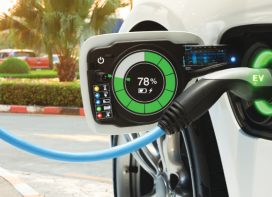In market sectors running the gamut from agriculture to manufacturing, every step in the production and transit process presents challenges that can make or break a supply chain. However, the Internet of Things (IoT) is about to revolutionize the logistics domain. Offering many advantages and opportunities, IoT-based solutions are becoming widely introduced in the sector. TrafficInfraTech speaks to a few IoT solution providers catering to the logistics sector to understand the IoT ecosystem and the challenges.
Whether manufacturing, retail, distribution, or shipping, planning and managing the flow of raw materials and finished goods through the supply chain is a challenge. Materials are often improperly shipped or stored, which can damage sensitive goods. Plus, the sheer size and capacity of a large operation can lead to disorganization in a manufacturing warehouse or distribution facility.
A few years ago, transportation and logistics meant only using IR technologies and similar which came with a lot of infrastructure and a significant installation price. All this has changed today with the rise of assettracking solutions.
The priority of all logistics companies is to have just-in-time delivery, supply chain visibility, product lifecycle transparency and quality services. The success of any logistics company lies in efficient inventory management and warehousing, automation of internal business processes, fast delivery and taking care of safe storage and quality of goods.
The transportation and logistics industry is one of the leading segments investing heavily in IoT. Smart transportation that is enabled by IoT has brought in a rapid change in the industry with the help of emerging technologies along with mobile connectivity, creating a seamless interface.
 “IoT has been around since quite some time now. We can see decade old TMS applications promoting standard digitization and connected architecture to improve logistics and fleet operations. However, it is the advent of groundbreaking cloudbased technologies, powered by machine learning and AI, which are revolutionizing the logistics domain. Hard installed Tracker’s, wireless GPS devices, sensors and more such devices making up the IoT ecosystem have been there since ages. It is the data analytics back-end which is now the differentiating factor,” explains Sharjeel Siddiqui, Head of Marketing, Loginext Solutions. He further adds, “IoT has complemented the integration economy giving rise to simplification of how different products communicate and pass data. For the logistics and supply chain industry, these integrations have increased the possibility of deploying multiple solutions based on IoT to improve operational efficiency, on-ground visibility, people management, data analytics, costcutting and so on and so forth.”
“IoT has been around since quite some time now. We can see decade old TMS applications promoting standard digitization and connected architecture to improve logistics and fleet operations. However, it is the advent of groundbreaking cloudbased technologies, powered by machine learning and AI, which are revolutionizing the logistics domain. Hard installed Tracker’s, wireless GPS devices, sensors and more such devices making up the IoT ecosystem have been there since ages. It is the data analytics back-end which is now the differentiating factor,” explains Sharjeel Siddiqui, Head of Marketing, Loginext Solutions. He further adds, “IoT has complemented the integration economy giving rise to simplification of how different products communicate and pass data. For the logistics and supply chain industry, these integrations have increased the possibility of deploying multiple solutions based on IoT to improve operational efficiency, on-ground visibility, people management, data analytics, costcutting and so on and so forth.”
The success of any logistics company is to move the right product in the right quantity and condition at the right time and right location with the right price to the right customer. This is termed as the 7 R’s. Given the complexity of the task at hand, there is an increasing demand for making use of innovative solutions to achieve goals.
 According to Kushal Nahata, CEO & Co-founder, FarEye, IoT powered devices empower supply chain and logistics stakeholders to drastically boost visibility of delivery processes, especially when operating in areas suffering from poor connectivity. “Apart from b eing able to track the location of goods during delivery, the use of IoT powered solutions also simplifies the process of fleet management. IoT-sensors can quickly transmit data pertaining to uncertain variables like stock shortages, sudden changes in temperature, etc, which could be instantly sent to supply chain stakeholders for them to take necessary measures.”
According to Kushal Nahata, CEO & Co-founder, FarEye, IoT powered devices empower supply chain and logistics stakeholders to drastically boost visibility of delivery processes, especially when operating in areas suffering from poor connectivity. “Apart from b eing able to track the location of goods during delivery, the use of IoT powered solutions also simplifies the process of fleet management. IoT-sensors can quickly transmit data pertaining to uncertain variables like stock shortages, sudden changes in temperature, etc, which could be instantly sent to supply chain stakeholders for them to take necessary measures.”
In short, what Nahata points out is that IoT-powered supply chains can drastically improve visibility of the entire delivery process starting with goods being moved from a warehouse.
Bringing with its smart connections and use cases, IoT is about to revolutionize the logistics domain. Supply chain monitoring, vehicle tracking, inventory management, safe transportation and automation of processes are the key to IoT applications.
When asked about the recent trends for IoT catering to the logistics and transport sector, Siddiqui informs, “Especially for the logistics and transport sector, three major trends can be observed that are cropping up in the last five years. They are- end-toend digitization, seamless mobility, and enhanced visibility. It would be fair to state that IoT has become the most important factor behind operational scaling and making the mobility ecosystem more efficient. To give specific examples of the IoT landscape in the 3PL industry -we have seen the US Department of Transportation enforce ELD norms across the US, similar infrastructural changes have been regulated across the globe. We have also seen massive adoption of wired and wireless trackers for the transport vehicle and mobile app-based tracking for drivers and other field executives by large enterprises globally.”
 TrafficInfraTech Magazine Linking People Places & Progress
TrafficInfraTech Magazine Linking People Places & Progress


